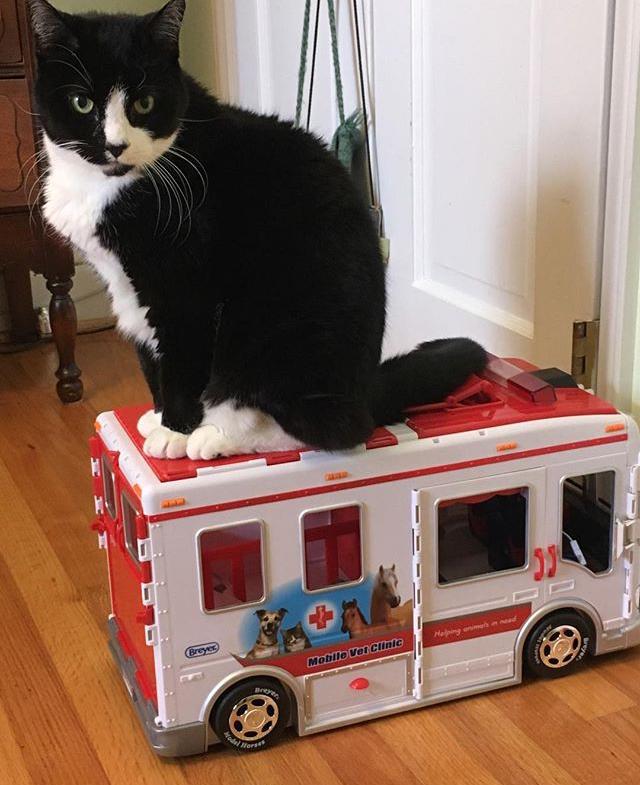There’s a new tool to find out

Credit: Margaret Gruen
With an estimated 10-15% of adults over the age of 60 having some degree of osteoarthritis, otherwise known as degenerative joint disease (DJD), many people will be familiar with, or will know someone who suffers from, this painful and debilitating condition. What is not well recognised is that DJD, where the protective cartilage that cushions the end of the bones wears down over time, affects a high proportion of pet cats of all age groups, but particularly those 10 years of age and over. A study published today in the Journal of Feline Medicine and Surgery (JFMS)1 provides a screening checklist to help veterinarians and owners to identify cats experiencing DJD-associated pain.
The team of researchers that developed the new tool are based at North Carolina State University (NCSU) in the USA, and led by Margaret Gruen and Duncan Lascelles. They were concerned that feline DJD remains underdiagnosed and undertreated in veterinary practice despite its high prevalence; earlier research has revealed, for example, that 90% of cats are likely to have radiographic signs of DJD, with at least 40% showing related signs of pain. The authors suggest that one possible reason for this is that while many people may associate limping with joint pain, this is actually a less common sign of DJD in cats. Meanwhile other, more typical behavioral signs of DJD (such as difficulty navigating stairs) may be misinterpreted as normal aging.
In their study, the authors collated questionnaire data from five studies previously carried out at the Translational Research in Pain Program at NCSU. This enabled them to compare 249 cats with, and 53 cats without, DJD-associated pain, and, via a multistep process of analysis, develop a set of questions that can be answered with a straightforward ‘yes’ or ‘no’. After some further refinement, they came up with a final checklist comprising six questions. These ask whether a cat can jump up and down normally, climb up and down stairs normally and run normally, and whether it chases moving objects such as toys and prey. The checklist can also be used for owners and cats living in a single-storey home by excluding the questions about stairs.
In developing this new tool, referred to as the ‘Feline Musculoskeletal Pain Screening Checklist’, the researchers compared the scoring of owners who were both aware or unaware of the link between DJD and pain in cats. Unsurprisingly, they found a gap in the responses between the groups, with a higher percentage of ‘DJD-informed’ owners scoring their cats as impaired for every question. The authors suggest that, given the high prevalence of feline DJD, many cats with undiagnosed DJD would nonetheless still be identified using the checklist; and, when coupled with owner education and engagement in watching for behavioural changes in their cats, the detection of DJD should improve even more.
The authors conclude that this checklist not only provides a clinically expedient tool likely to increase vets’ ability to screen for DJD pain in cats, but it may also further provide a foundation for increasing awareness of DJD pain among cat owners. Cats being cats are more likely to display behavioural signs of DJD-associated pain at home compared with in the veterinary clinic, meaning owners are well placed to help in the diagnosis of this condition. The idea is that the checklist can be completed quickly by owners, and if ‘no’ is selected for any question, this will prompt further evaluation by the vet and treatment to improve the cat’s comfort levels.
###
References/resources
1. Enomoto M, Lascelles BDX and Gruen ME. Development of a checklist for the detection of degenerative joint disease-associated pain in cats. J Feline Med Surg. Epub ahead of print 3 March 2020. DOI: 10.1177/1098612X20907424. The article is free to read here: https:/
Animations indicating how healthy cats and cats with DJD-associated pain might perform each of the activities in the Feline Musculoskeletal Pain Screening Checklist can be found as part of a larger checklist at: http://catoachecklist.
Picture: A cat diagnosed with degenerative joint disease may still be able to enjoy good quality of life, as shown here by the author’s own 18-year-old cat! Diagnosis is key, however, and this simple checklist will help owners determine whether their cat needs veterinary evaluation and treatment. Credit: Margaret Gruen
Notes to editors:
About the Journal of Feline Medicine and Surgery
The Journal of Feline Medicine and Surgery (jfms.com) is the official journal of the International Society of Feline Medicine (ISFM) and the American Association of Feline Practitioners (AAFP), and is published by SAGE Publishing.
Media Contact
Hannah Turner
[email protected]
44-017-478-71872
Related Journal Article
http://dx.




